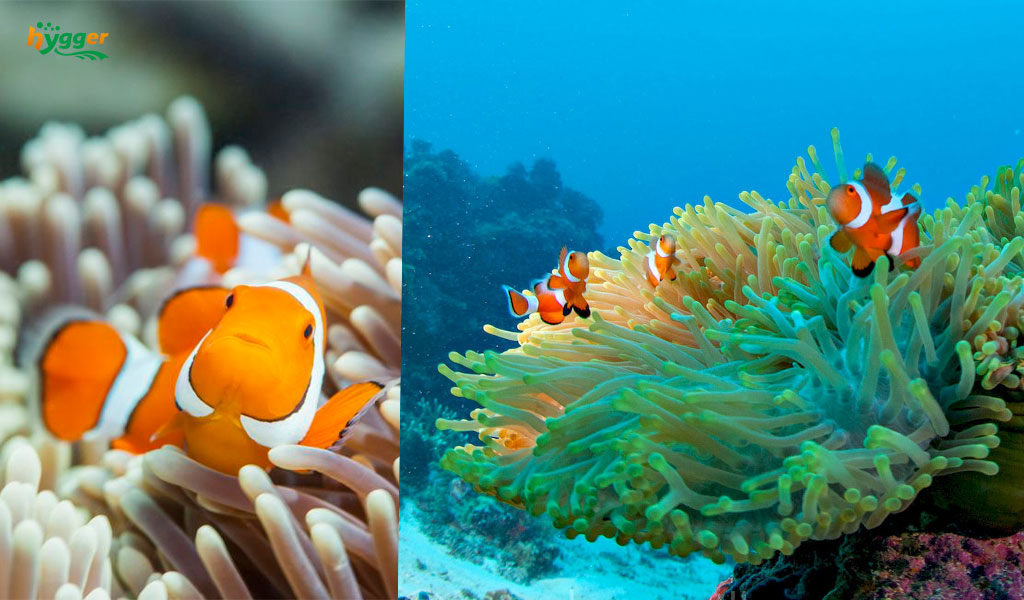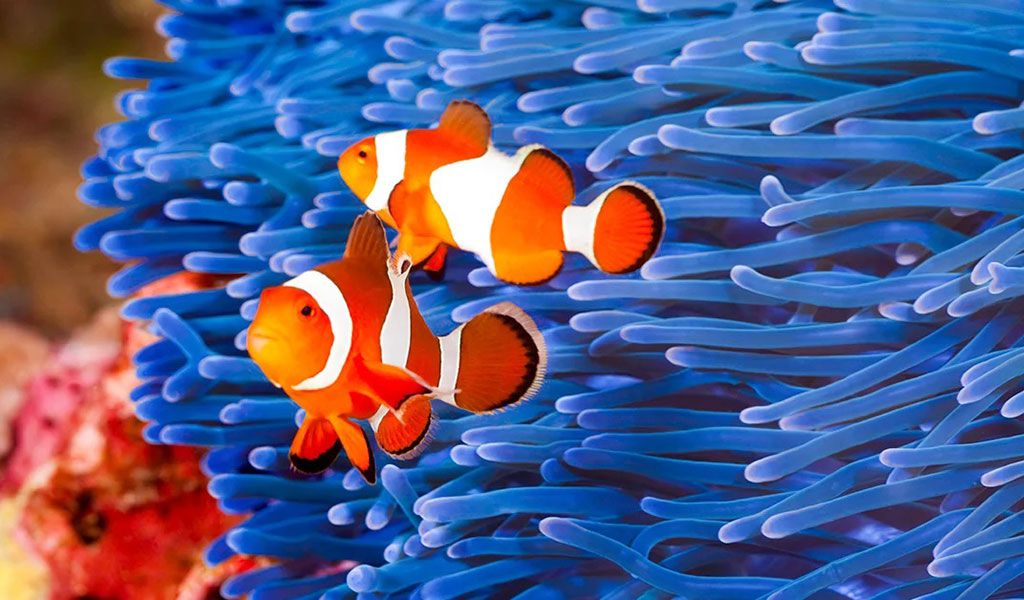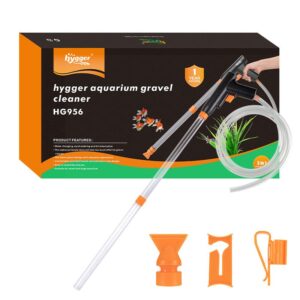Have you seen the animated film Finding Nemo? If the answer is positive, you surely know Ocellaris Clownfish (Amphiprion ocellaris), named Nemo in the film. They gained significant popularity through this film. As one of the most popular ones among Clownfish species, the Ocellaris Clownfish features a vibrant orange body color with white stripes outlined in black. By now. If you have never seen that film but are interested in Clownfish, read on to find out more about them.
Content Table
Clownfish Biodiversity
Clownfish, also known as anemone fish, are small and vibrant reef-dwelling fish. They exhibit a remarkable diversity of colors, patterns, and behaviors. For instance, the colors range from bright oranges, yellows, and reds to combinations of white, black, and even blue. In this segment, we will list some common species.
| Fish name | Brief info |
| Ocellaris Clownfish (Amphiprion ocellaris) | Belonging to the Pomacentridae family, they have a vibrant orange body color with white stripes outlined in black. |
| Percula Clownfish (Amphiprion percula) | This species is similar to the Ocellaris clownfish but has brighter orange coloring and more distinct black margins on its fins. |
| Clark’s Clownfish (Amphiprion clarkii) | Clark’s clownfish displays various color patterns, including black, orange, and yellow variations. |
| Two-Banded Clownfish (Amphiprion bicinctus) | This species has two distinct white bands across its body and is often found in the Red Sea and the Indian Ocean. |
| Maroon Clownfish (Premnas biaculeatus) | Maroon clownfish have a deep red or maroon coloration and are known for being one of the larger species of clownfish. |
| Tomato Clownfish (Amphiprion frenatus) | Tomato Clownfish has a striking red body with thin black margins on its white stripes. It is found in the Indo-Pacific region, from the eastern coast of Africa to the western Pacific Ocean. |

Clownfish and anemone
Get to know Clownfish and anemone
Exactly, Clownfish and anemones have a symbiotic relationship. Clownfish find protection and shelter among the tentacles of anemones, while they also provide various benefits to anemones. Next, we will cover some key aspects of the symbiosis between Clownfish and anemones.
- Protection
The presence of clownfish deters potential predators from approaching the anemone. Clownfish use their bright colors and bold behavior to attract predators, which become entangled in the anemone’s stinging tentacles. The clownfish benefit from the anemone’s protection, as they can seek refuge within its tentacles when threatened.
- Food and nutrients
Clownfish produce waste containing nitrogen compounds, providing the anemone with a constant source of nutrients. They also clean the anemone by consuming parasites and debris, contributing to the anemone’s overall health.
- Aeration and waster removal
The constant movement of clownfish within the anemone helps to circulate water around the anemone’s body, promoting oxygen flow and waste removal.
However, not all clownfish species associate with anemones, and not all anemones host clownfish. The specific partnership between clownfish and anemones can vary among species. Also, the specific types of anemones that clownfish associate with can vary, but common ones include species from the genera Heteractis and Entacmaea.

The requirements of living environment for Clownfish
- Aquarium size
Clownfish can be kept in aquariums of various sizes, depending on the species. For a single pair or small group of clownfish, a tank of at least 20 gallons (75 liters) is generally recommended. Larger species or larger groups would require larger tanks to accommodate their needs.
- Substrate and aquarium decor
You can use live rocks or artificial decors to create hiding places, territories, and suitable substrates for the growth of beneficial bacteria. Plus, Clownfish have fancy caves, crevices, and anemone-like structures that provide shelter and security.
- Anemone or substrate alternatives
While clownfish can form a symbiotic relationship with anemones, keeping anemones in the aquarium is unnecessary. Anemones can be challenging to maintain, and Clownfish can thrive without them. Alternatively, it is feasible to provide suitable substitutes, such as coral colonies, PVC pipe structures, or other decorations that provide shelter and mimic the anemone’s appearance.
- Water parameters
| Water temperature | 75-82℉ (24-28℃) | Calcium level | 380-450 ppm |
| pH level | 8.0-8.4 | Magnesium level | 1200-1400 ppm |
| Salinity level (specific gravity) | 1.020-1.025 | Ammonia /Nitrite level | 0 ppm |
| Carbonate hardness /alkalinity | 7-12 dKH | Nitrate level | Below 20 ppm |
- Filtration and water flow
Clownfish prefer moderate water flow, simulating the gentle currents found on coral reefs. Accordingly, you can apply a qualified filtration system, such as a protein skimmer, along with power heads or wave makers to provide adequate water movement and oxygenation.
- Lighting
Clownfish do not have specific lighting requirements, but providing a marine lighting system that supports the growth of live corals or anemones in the tank is beneficial.
What do clownfish eat
Clownfish are omnivorous. In the wild, their diet primarily consists of small invertebrates, zooplankton, algae, and leftover food from the anemone. In captivity, it is vital to provide a balanced and varied diet that replicates their natural feeding habits. This part will give you some common food options.

Commercial foods
High-quality marine pellets or flakes specifically formulated for saltwater fish can serve as the staple diet for clownfish. Just look for products that are specifically designed for marine omnivores.
Frozen foods
You can supplement the diet of Clownfish with frozen foods. For example, brine shrimp, mysis shrimp, chopped seafood (like fish or shrimp), plankton, etc. These foods provide essential nutrients and are similar to the small invertebrates they would consume in the wild.
Live foods
Clownfish can be fed live foods occasionally to mimic their natural hunting behavior. Artemia (brine shrimp), copepods, and other small live invertebrates can be great choices.
Algae and seaweed
Clownfish consume algae in the wild. So you can provide small amounts of marine algae or seaweed, specifically made for herbivorous fish. Just attach them to a clip or suction cup near the water surface for easy consumption.
Overall, you should ensure a varied diet to keep optimal nutrition. It is viable to offer small portions multiple times each day. Besides, remove uneaten food from your tank to reduce the risk of poor water quality.
Do barracudas eat clownfish
Barracudas & Clownfish
In the natural environment, Barracudas and Clownfish do not share the same habitat. Barracudas prefer deeper waters and open ocean habitats, while Clownfish are typically found in shallower coastal waters near coral reefs, where they establish territories and utilize the coral structures for shelter. Therefore, it is not common for Barracudas to consume Clownfish in their natural habitat.
Nonetheless, if you keep the two together in one tank, there is a high risk that the barracudas may view the clownfish as prey and attempt to eat them. To ensure the well-being and safety of both species, it is best to keep them in separate aquariums.

Compatible tank mates for Clownfish
When it comes to tank mates for Clownfish, you can consider factors like compatibility, size, and behavior. Typically, peaceful ones can be the first option. The following are some compatible tank mates for Clownfish:
| Blue Devil Damsel (Chrysiptera cyanea) | Yellowtail Damsel (Chrysiptera parasema) | Tailspot Blenny (Ecsenius stigmatura) |
| Firefish Goby (Nemateleotris magnifica) | Yellow Watchman Goby (Cryptocentrus cinctus) | Lawnmower Blenny (Salarias fasciatus) |
| Royal Gramma (Gramma loreto) | Pajama Cardinalfish (Sphaeramia nematoptera) | Reef-safe invertebrates (e.g. shrimp, snails, and small hermit crabs) |
| Yellow Tang (Zebrasoma flavescens) | Kole Tang (Ctenochaetus strigosus) | Six-Line Wrasse (Pseudocheilinus hexataenia) |
Wrap-up
Clownfish are generally peaceful saltwater fish. One interesting aspect is that they form a hierarchical social structure. They live in small family groups consisting of a dominant breeding pair, with the largest and most aggressive fish being the female, and a few smaller and less dominant males. In the absence of the dominant female, the largest male can undergo a sex change and become the new female, ensuring the continuity of the group.


Leave a comment